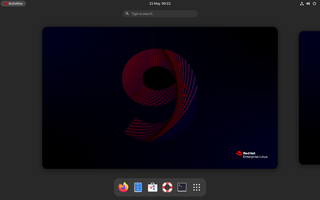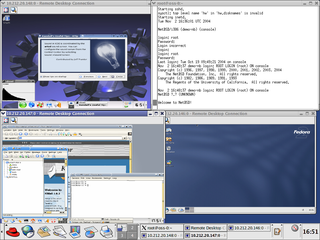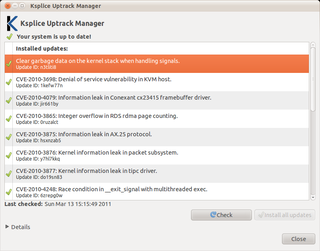
A rootkit is a collection of computer software, typically malicious, designed to enable access to a computer or an area of its software that is not otherwise allowed and often masks its existence or the existence of other software. The term rootkit is a compound of "root" and the word "kit". The term "rootkit" has negative connotations through its association with malware.
A patch is a set of changes to a computer program or its supporting data designed to update, fix, or improve it. This includes fixing security vulnerabilities and other bugs, with such patches usually being called bugfixes or bug fixes. Patches are often written to improve the functionality, usability, or performance of a program. The majority of patches are provided by software vendors for operating system and application updates.

Red Hat Enterprise Linux (RHEL) is a commercial open-source Linux distribution developed by Red Hat for the commercial market. Red Hat Enterprise Linux is released in server versions for x86-64, Power ISA, ARM64, and IBM Z and a desktop version for x86-64. Fedora Linux serves as its upstream source. All of Red Hat's official support and training, together with the Red Hat Certification Program, focuses on the Red Hat Enterprise Linux platform.

Xen is a type-1 hypervisor, providing services that allow multiple computer operating systems to execute on the same computer hardware concurrently. It was originally developed by the University of Cambridge Computer Laboratory and is now being developed by the Linux Foundation with support from Intel, Citrix, Arm Ltd, Huawei, AWS, Alibaba Cloud, AMD, Bitdefender and epam.
A softmod is a method of using software to modify the intended behavior of hardware, such as video cards, sound cards, or game consoles in a way that can overcome restrictions of the firmware, or install custom firmware.
Free60 is the successor to the Xbox Linux Project that aims to put Linux, BSD, or Darwin on the Microsoft Xbox 360 using a software or hardware based "hack". The Xbox 360 uses hardware encryption and will not run unsigned code out of the box.

Oracle Linux is a Linux distribution packaged and freely distributed by Oracle, available partially under the GNU General Public License since late 2006. It is compiled from Red Hat Enterprise Linux (RHEL) source code, replacing Red Hat branding with Oracle's. It is also used by Oracle Cloud and Oracle Engineered Systems such as Oracle Exadata and others.

Kernel Patch Protection (KPP), informally known as PatchGuard, is a feature of 64-bit (x64) editions of Microsoft Windows that prevents patching the kernel. It was first introduced in 2005 with the x64 editions of Windows XP and Windows Server 2003 Service Pack 1.
A virtual security appliance is a computer appliance that runs inside virtual environments. It is called an appliance because it is pre-packaged with a hardened operating system and a security application and runs on a virtualized hardware. The hardware is virtualized using hypervisor technology delivered by companies such as VMware, Citrix and Microsoft. The security application may vary depending on the particular network security vendor. Some vendors such as Reflex Systems have chosen to deliver Intrusion Prevention technology as a Virtualized Appliance, or as a multifunctional server vulnerability shield delivered by Blue Lane. The type of security technology is irrelevant when it comes to the definition of a Virtual Security Appliance and is more relevant when it comes to the performance levels achieved when deploying various types of security as a virtual security appliance. Other issues include visibility into the hypervisor and the virtual network that runs inside.
kexec, abbreviated from kernel execute and analogous to the Unix/Linux kernel call exec, is a mechanism of the Linux kernel that allows booting of a new kernel from the currently running one. Essentially, kexec skips the bootloader stage and hardware initialization phase performed by the system firmware, and directly loads the new kernel into main memory and starts executing it immediately. This avoids the long times associated with a full reboot, and can help systems to meet high-availability requirements by minimizing downtime.

Ksplice is an open-source extension of the Linux kernel that allows security patches to be applied to a running kernel without the need for reboots, avoiding downtimes and improving availability. Ksplice supports only the patches that do not make significant semantic changes to kernel's data structures.

The Blue Screen of Death (BSoD), officially known as a Stop error, Blue screen error, fatal error, or bugcheck is an error screen displayed by the Microsoft Windows or ReactOS operating systems.

The Linux kernel is a free and open-source, monolithic, modular, multitasking, Unix-like operating system kernel. It was originally authored in 1991 by Linus Torvalds for his i386-based PC, and it was soon adopted as the kernel for the GNU operating system, which was written to be a free (libre) replacement for Unix.

Linux-libre is a modified version of the Linux kernel that contains no binary blobs, obfuscated code, or code released under proprietary licenses. In the Linux kernel, they are mostly used for proprietary firmware images. While generally redistributable, binary blobs do not give the user the freedom to audit, modify, or, consequently, redistribute their modified versions. The GNU Project keeps Linux-libre in synchronization with the mainline Linux kernel.
In computer science, dynamic software updating (DSU) is a field of research pertaining to upgrading programs while they are running. DSU is not currently widely used in industry. However, researchers have developed a wide variety of systems and techniques for implementing DSU. These systems are commonly tested on real-world programs.

Checkpoint/Restore In Userspace (CRIU), is a software tool for the Linux operating system. Using this tool, it is possible to freeze a running application and checkpoint it to persistent storage as a collection of files. One can then use the files to restore and run the application from the point it was frozen at. The distinctive feature of the CRIU project is that it is mainly implemented in user space, rather than in the kernel.
kGraft is a feature of the Linux kernel that implements live patching of a running kernel, which allows kernel patches to be applied while the kernel is still running. By avoiding the need for rebooting the system with a new kernel that contains the desired patches, kGraft aims to maximize the system uptime and availability. At the same time, kGraft allows kernel-related security updates to be applied without deferring them to scheduled downtimes. Internally, kGraft allows entire functions in a running kernel to be replaced with their patched versions, doing that safely by selectively using original versions of functions to ensure per-process consistency while the live patching is performed.
kpatch is a feature of the Linux kernel that implements live patching of a running kernel, which allows kernel patches to be applied while the kernel is still running. By avoiding the need for rebooting the system with a new kernel that contains the desired patches, kpatch aims to maximize the system uptime and availability. At the same time, kpatch allows kernel-related security updates to be applied without deferring them to scheduled downtimes. Internally, kpatch allows entire functions in a running kernel to be replaced with their patched versions, doing that safely by stopping all running processes while the live patching is performed.

Meltdown is one of the two original transient execution CPU vulnerabilities. Meltdown affects Intel x86 microprocessors, IBM POWER processors, and some ARM-based microprocessors. It allows a rogue process to read all memory, even when it is not authorized to do so.
Container Linux is a discontinued open-source lightweight operating system based on the Linux kernel and designed for providing infrastructure to clustered deployments, while focusing on automation, ease of application deployment, security, reliability and scalability. As an operating system, Container Linux provided only the minimal functionality required for deploying applications inside software containers, together with built-in mechanisms for service discovery and configuration sharing.










